A great deal of travel writing falls into one of two categories. There’s “first encounter” writing, in which the author recalls their first visit to a place, or the first time they came across a particular cultural practice. And then there’s the “guidebook” approach, in which the description of a location is the result of multiple visits to it over months or even years.
Or, to put it another way, tales of discovery versus tales of familiarity.
This article is an example of the latter. For the better part of a decade, I’ve been coming to a corner of Tainan where Guanmiao District (關廟) borders Longci District (龍崎), to ramble on foot or by bicycle.
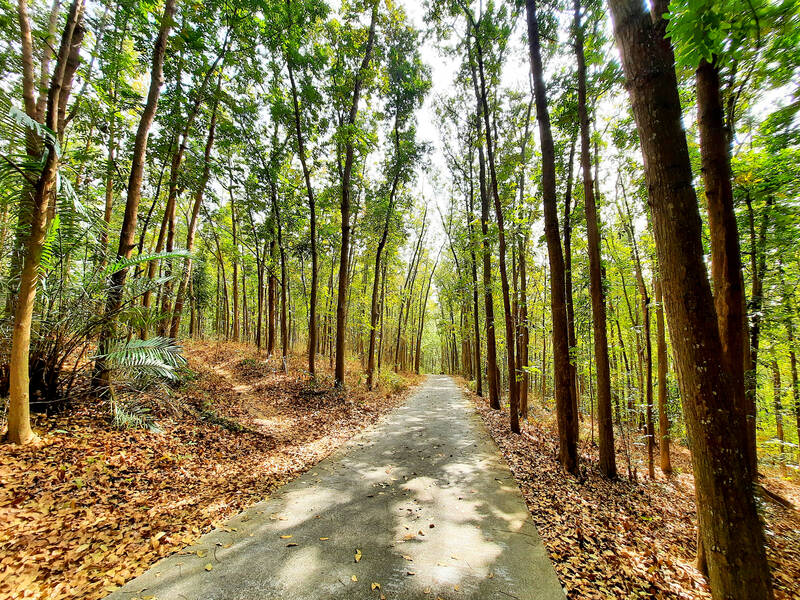
Photo: Steven Crook
It’s a pleasing blend of tiny farms, minor hills and bamboo groves. I can’t say the area offers unspoiled countryside, as Freeway 3 slices through this landscape, much of which is 50 to 100m above sea level. Yet, even when fast traffic is audible, the woodlands hereabouts provide a very worthwhile escape-from-the-city experience.
I’m certainly not the only person who thinks that. Every time I go through what bilingual signs refer to as the Mahogany Forest Park (桃花心木森林公園) — also known as Guanmiao Forest Trail (關廟森林步道) — I meet other people taking photos or doing exercise. The area is kept tidy by volunteers who sweep leaves off the road surface.
If you’ve not been to the Mahogany Forest before, finding it can be a little tricky. First, get onto Wanglai Road (旺萊路) near central Guanmiao, then look for Dongrong Street (東榮街). The latter goes past ordinary homes and then several small factories before climbing steeply.
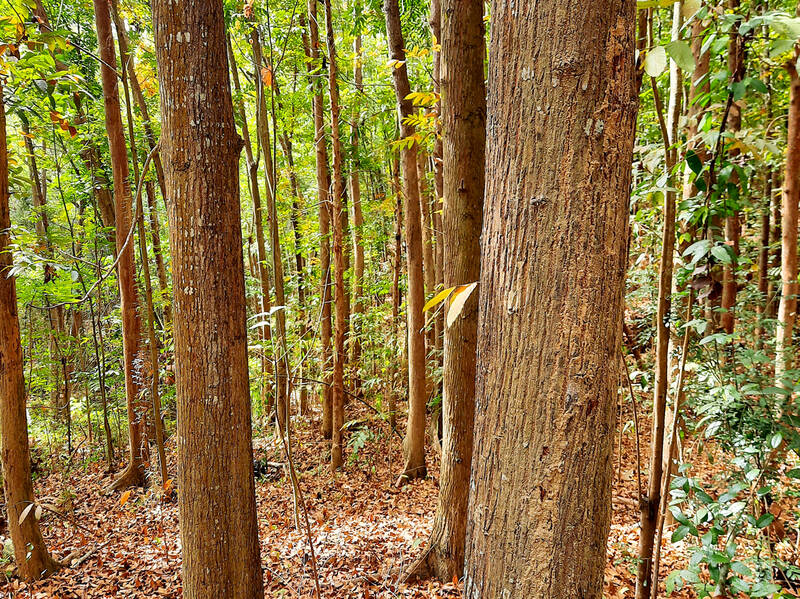
Photo: Steven Crook
There are clusters of graves on both sides of the road, and a few vegetable patches. If you’re riding a bike or a motorcycle, you can stop almost anywhere. If you’re in a car, however, the best place to park without inconveniencing others is at the Temple of the Three Marshals (三元帥廟), just under 2km from the Wanglai Road-Dongrong Street intersection. There’s space for four or five vehicles, but no bathroom.
By the time you get to the temple, it’ll be obvious that the surrounding forest is a plantation rather than one of Mother Nature’s efforts. Yet it’s a lovely sight whatever the month, whether it’s just after dawn, the middle of the day or close to dusk.
The finest views are to be had by following the car-width road from the Temple of the Three Marshals to a point about 800m to the south. Beyond that, the road descends past stands of bamboo, then runs parallel to Freeway 3 for a short distance.
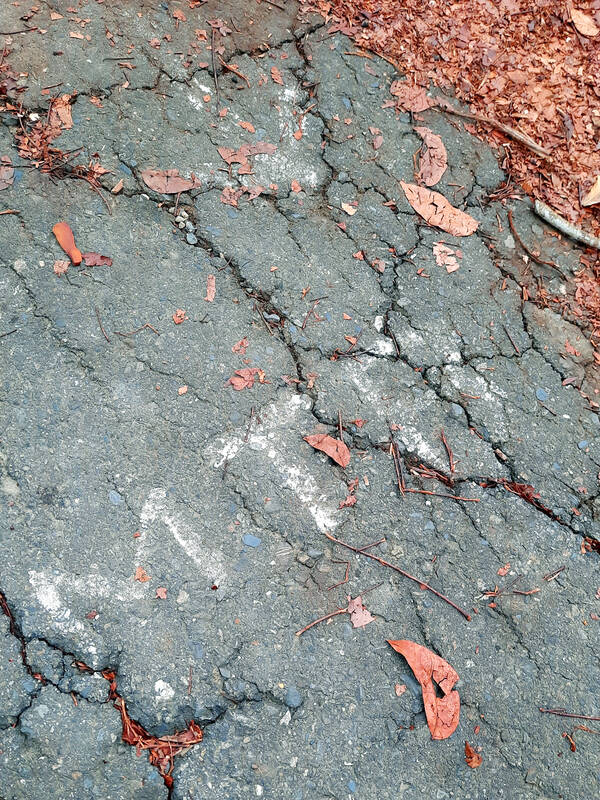
Photo: Steven Crook
The Guanmiao-Longci mahogany plantation dates from the late 1990s, when 100 hectares of slopeland was afforested by its owner, Taiwan Kagome Co Ltd (臺灣可果美), to underscore its commitment to the environment. Some 60 hectares were planted with Honduras mahogany (Swietenia macrophylla), while the remainder is covered by a mix of hoop pine (Araucaria cunninghamii), smooth narra (also known as Philippine mahogany, Pterocarpus indicus), and an endemic evergreen, Machilus zuihoensis.
As its name suggests, Honduras mahogany is native to Central America. It’s now fairly common in central and southern Taiwan, where it’s grown to provide shade, timber for furniture and musical instruments and extracts that are used in traditional Chinese medicine.
Something about this terrain — probably the numerous gulches and gullies that break up the surface, and make venturing more than a meter or two from the asphalt inadvisable — facilitates mosquito breeding. For many visitors, the near certainty they’ll get bitten is their only complaint. But it’s a common gripe, whatever the season.
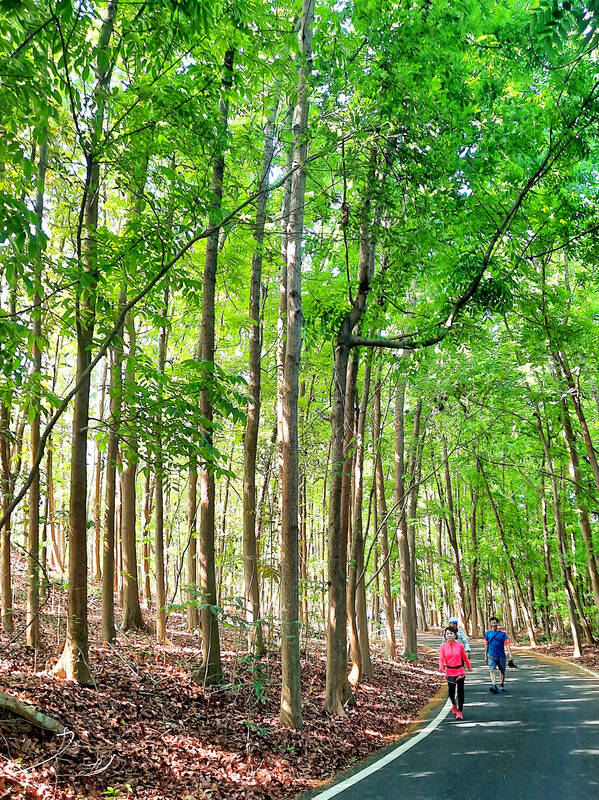
Photo: Steven Crook
The road through the Mahogany Forest continues under the freeway, then goes uphill to a small village called Dasi (大溪), where the main landmark is Jhongkeng Cingshuei Temple (中坑里清水宮). From Dasi, one can ride or drive to Road 182, or take a delightful road southward toward Alian (阿蓮) in Kaohsiung.
A few times, I’ve left my bike or motorcycle under the freeway, and walked up a steep concrete track that’s just to the east of the fast road, on the southside of a creek.
It leads past tracts of man-made forest and pineapple fields to a bridge over Freeway 3. On the other (seaward) side, there’s a very narrow “road” that’s been damaged by the elements and distorted by soil erosion to the point where ordinary two-wheelers shouldn’t attempt it. Mountain bike enthusiasts have marked out an MTB route along it, but I’ve not been able to discover where it starts and ends, its precise length or if there are regular events.
After around 900m of meandering through the Taiwan Kagome estate, this strip of broken-up concrete reaches a dank yet mercifully short tunnel under the freeway. On the other side, it joins up with a much more user-friendly road just behind Guanmiao Service Area (關廟服務區) on Freeway 3 — and within 300m, as the crow flies, of the final resting place of Taiwan’s ketchup king.
According to one biography, Lin Hsi-chih (林錫池, 1918-1995) was a ninth-generation descendant of settlers from Fujian. Educated during the 1895-1945 period of Japanese rule, the postwar years found him teaching at what’s now National Cheng Kung University. Later, he launched a company to export bananas and canned food to Japan.
In 1967, he entered into a joint venture with Japan’s Kagome Co Ltd. Production of tomato-based products began the following year, and Taiwan Kagome soon became synonymous with tomato ketchup and tomato juice. The company, now managed by Lin’s grandson, has since expanded into vegetable and fruit juices.
In addition to his contributions to Taiwan’s processed foods industry, Lin might well have had a hand in creating the corporate culture that resulted in one of Tainan’s most attractive and accessible woodlands. I’m willing to give him the benefit of any doubt, and say that he deserves his slumber.
Steven Crook has been writing about travel, culture and business in Taiwan since 1996. He is the author of Taiwan: The Bradt Travel Guide and co-author of A Culinary History of Taipei: Beyond Pork and Ponlai.

Nine Taiwanese nervously stand on an observation platform at Tokyo’s Haneda International Airport. It’s 9:20am on March 27, 1968, and they are awaiting the arrival of Liu Wen-ching (柳文卿), who is about to be deported back to Taiwan where he faces possible execution for his independence activities. As he is removed from a minibus, a tenth activist, Dai Tian-chao (戴天昭), jumps out of his hiding place and attacks the immigration officials — the nine other activists in tow — while urging Liu to make a run for it. But he’s pinned to the ground. Amid the commotion, Liu tries to
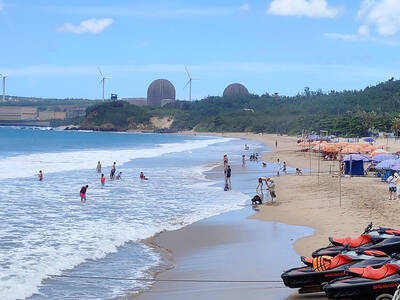
A dozen excited 10-year-olds are bouncing in their chairs. The small classroom’s walls are lined with racks of wetsuits and water equipment, and decorated with posters of turtles. But the students’ eyes are trained on their teacher, Tseng Ching-ming, describing the currents and sea conditions at nearby Banana Bay, where they’ll soon be going. “Today you have one mission: to take off your equipment and float in the water,” he says. Some of the kids grin, nervously. They don’t know it, but the students from Kenting-Eluan elementary school on Taiwan’s southernmost point, are rare among their peers and predecessors. Despite most of

A pig’s head sits atop a shelf, tufts of blonde hair sprouting from its taut scalp. Opposite, its chalky, wrinkled heart glows red in a bubbling vat of liquid, locks of thick dark hair and teeth scattered below. A giant screen shows the pig draped in a hospital gown. Is it dead? A surgeon inserts human teeth implants, then hair implants — beautifying the horrifyingly human-like animal. Chang Chen-shen (張辰申) calls Incarnation Project: Deviation Lovers “a satirical self-criticism, a critique on the fact that throughout our lives we’ve been instilled with ideas and things that don’t belong to us.” Chang
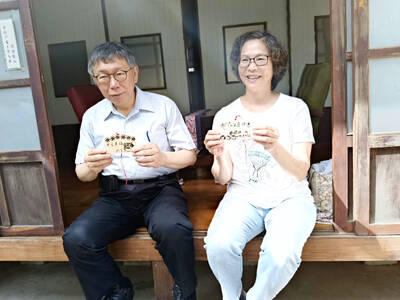
The resignation of Taiwan People’s Party (TPP) co-founder Ko Wen-je (柯文哲) as party chair on Jan. 1 has led to an interesting battle between two leading party figures, Huang Kuo-chang (黃國昌) and Tsai Pi-ru (蔡壁如). For years the party has been a one-man show, but with Ko being held incommunicado while on trial for corruption, the new chair’s leadership could be make or break for the young party. Not only are the two very different in style, their backgrounds are very different. Tsai is a co-founder of the TPP and has been with Ko from the very beginning. Huang has